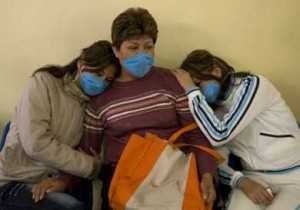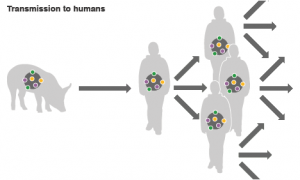 Swine flu was first reported in 20th century and is mostly common in pigs of United states, Mexico, Canada, Tiawan, Japan, Kenya, Europe and Eastern Asia. The transmission of swine fly to humans was not common earlier.
Swine flu was first reported in 20th century and is mostly common in pigs of United states, Mexico, Canada, Tiawan, Japan, Kenya, Europe and Eastern Asia. The transmission of swine fly to humans was not common earlier.
The Swine flu in 2009 is a result of a new strain of influenza A ( H1N1 ). The reports from W.H.O says that this influenza is not isolated in pigs, and can be transmitted from human to human also. WHO (World Health Organization) has issued alerts against the developing situation regarding the outbreak of swine flu A(H1N1). This awareness presentation provides a brief snapshot of the alert, symptoms of Infection, preventive measures, travel tips and the need for exercising caution, considering the existing global scenario. Media reports indicate affected countries as Mexico, USA, Europe, Canada with reports of spreading across countries. There is a global fear on a possible human pandemic predicted by experts in the bio medical field considering the probability of infection in humans.
What is Swine Flu
Swine Flu is new to humans and here is a brief summary:
- – Swine influenza, or swine flu, is a highly contagious acute respiratory disease of pigs, caused by one of several swine influenza A viruses.
- – The virus is spread among pigs by aerosols, direct and indirect contact, and asymptomatic carrier pigs. Outbreaks in pigs occur year round, with an increased incidence in the fall and winter in temperate zones.
- – Many countries routinely vaccinate swine populations against swine influenza.
- – Swine influenza viruses are most commonly of the H1N1 subtype, but other subtypes are also circulating in pigs (e.g., H1N2, H3N1, H3N2).
- – Pigs can also be infected with avian influenza viruses and human seasonal influenza viruses as well as swine influenza viruses.
- – The H3N2 swine virus was thought to have been originally introduced into pigs by humans. Sometimes pigs can be infected with more than one virus type at a time, which can allow the genes from these viruses to mix.
- – This can result in an influenza virus containing genes from a number of sources, called a reassortant virus. Although swine influenza viruses are normally species specific and only infect pigs, they do sometimes cross the species barrier to cause disease in humans.
How Swine Flu outbreak emerged?
 The name swine flu is a slight misnomer as it is believed pigs acted as a mixing pot for several flu strains, containing genetic material from pigs, birds and humans. Most humans have never been exposed to some of the antigens involved in the new strain of flu, giving it the potential to cause a pandemic.
The name swine flu is a slight misnomer as it is believed pigs acted as a mixing pot for several flu strains, containing genetic material from pigs, birds and humans. Most humans have never been exposed to some of the antigens involved in the new strain of flu, giving it the potential to cause a pandemic.
The new virus has made the jump from pigs to humans and has demonstrated it can also pass from human to human. This is why it is demanding so much attention from health authorities. The virus passes from human to human like other types of flu, either through coughing, sneezing, or by touching infected surfaces, although little is known about how the virus acts on humans.
How does Swine flu spread?
People usually get swine influenza from infected pigs, however, some human cases lack contact history with pigs or environments where pigs have been located. Spread of this swine influenza A (H1N1) virus is thought to be happening in the same way that seasonal flu spreads. Flu viruses are spread mainly from person to person through coughing or sneezing of people with influenza. Sometimes people may become infected by touching something with flu viruses on it and then touching their mouth or nose.
What are the signs and symptoms of swine flu in people?
The symptoms of swine flu in people are similar to the symptoms of regular human flu and include fever, cough, sore throat, body aches, headache, chills and fatigue. Some people have reported diarrhea and vomiting associated with swine flu. In the past, severe illness (pneumonia and respiratory failure) and deaths have been reported with swine flu infection in people. Like seasonal flu, swine flu may cause a worsening of underlying chronic medical conditions.
Symptoms of Swine Flu
Although, symptoms differ from person to person but here are few common symptoms:
- – Cough
- – Cold
- – Fever
- – Pneumonia
- – Sore Throat
- – Running/Stuffy Nose
- – Lethargy
- – Business Eyes
- – Muscle Joints aches
- – Fatigue/Weakness
Precautionary measures & Safety tips
Personal Hygiene
- – Cover your sneeze and cough well with a disposable tissue.
- – Adhere to good hand washing/cleaning procedures especially after sneezing or coughing. (Hand hygiene with simple soap and water).
- – Avoid close contact with any wild birds/animals. Stay away from zoos
- – As a social distancing measure, avoid close contact with people who appear unwell and who have fever and cough.
- – Ensure your regular workplace is kept clean.
- – Though no evidence of swine flu spread through eating non-vegetarian food, it is essential to ensure proper cooking of food before consumption.
- – If there is illness, immediately consult your General physician or Doctor’s Office.
Swine Flu Travel Care Tips
- – Personnel are advised to carefully consider their need to travel to Mexico at this time. Personnel should consider relocating meetings to unaffected locations or alternative working practices such as video-conferencing.
- – Personnel considering travel to Mexico should be aware that if the virus continues to spread, restrictions on movement may be imposed with little or no notice. Significant further deterioration in the situation could lead the authorities in Mexico and other countries to control/prohibit travel to and from effected areas placing restrictions on local and international travel.
- – International airports are currently operating normally in Mexico, though travelers are being screened for symptoms of the virus. Personnel should allow additional time for transiting through airports throughout the region because of screening procedures.
- – Travelers should ensure that their medical insurance is up-to-date and that they know how to activate it. Travelers should also check that their medical insurance is valid for travel to Mexico at this time . Personnel should know where to seek medical assistance during their trip
- – Travelers and expatriate residents should obtain preventative health advice and regular updates from the World Health Organization and the US Centers for Disease Control and Prevention. Monitor your health. If you develop symptoms such as fever, cough, headache and muscle pain, seek medical attention
I would love you to leave me a comment and let me hear your opinion. If you’ve got any thoughts, comments or suggestions for things we could add, leave a comment. Subscribe to our RSS for latest updates for free























